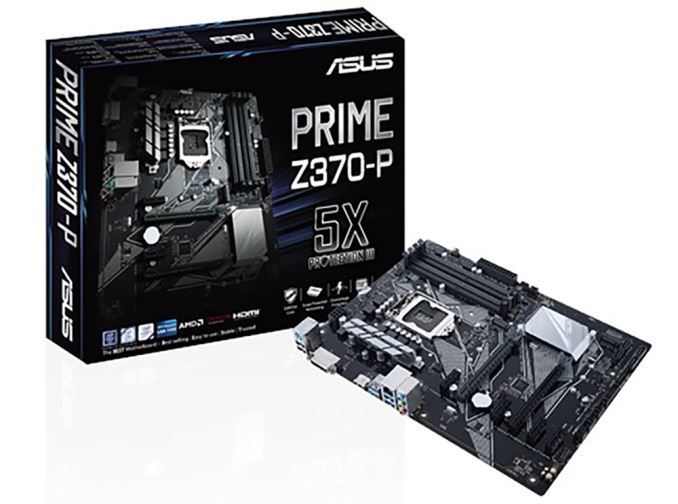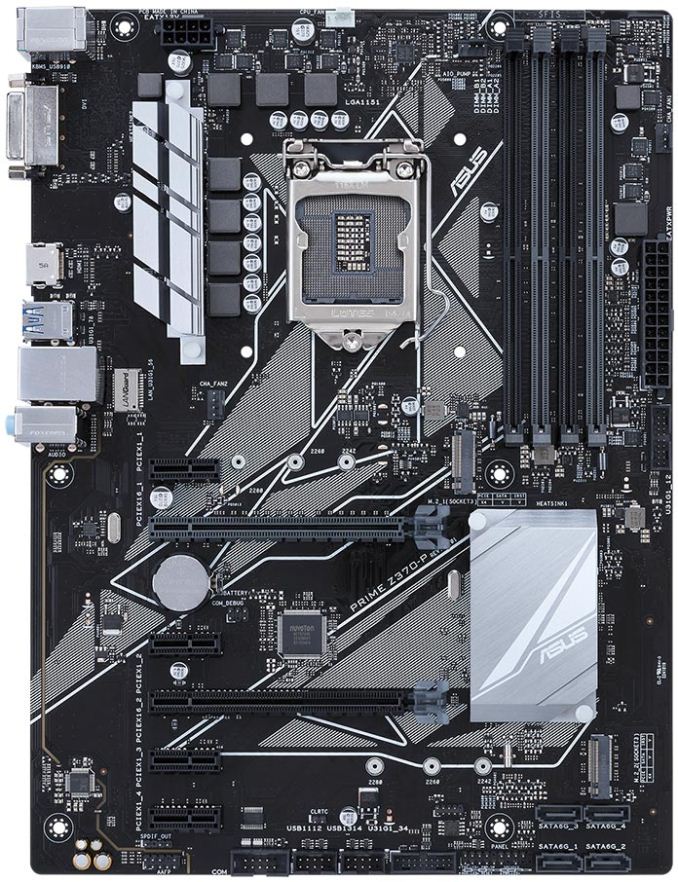Analyzing Z370 for Intel's 8th Generation Coffee Lake: A Quick Look at 50+ Motherboards
by Ian Cutress, Anton Shilov, Joe Shields & Gavin Bonshor on October 20, 2017 2:00 PM ESTASUS PRIME Z370-P
Following on from the second of two Prime branded boards at launch, the Z370-P has a completely different emphasis altogether. The priority has been shifted towards a broader focus on pure value, and the Z370-P comes in at the lowest price of all the ASUS Z370 motherboards. In comparison to the Z370-A Prime board, the Z370-P is considerably stripped down from all the bells and whistles, with this board sitting firmly on its laurels of a base Z370 motherboard but with ASUS optimizations.
This entry-level offering features a full sized ATX frame with four DIMM slots supporting up to DDR4-3866 with a maximum capacity of 64GB in total across all four DIMMs. This board is the only across the entire ASUS launched range not to feature Intel’s I219-V Gigabit network controller, instead opting for a more value orientated Realtek controller. Along with the TUF Gaming pairing, the Z370-P makes use of the more cost-effective Realtek ALC887 audio codec, and in this case, there is no EMI shielding. Dotted around the PCB, there is a dedicated header for AIO CPU cooling in addition to three 4-pin PWM compatible fan headers.
For the storage, the board uses a pair of M.2 PCIe x4 slots, with one either side of the full-length PCIe slots. This comes along with four SATA ports sticking out of the board on the bottom right. For PCIe slots, the top slot is a full-length PCIe 3.0 x16 slot whereas the second full-length slot is pulling its lanes directly from the chipset (PCIe x4). This means that only two-way Crossfire is possible using the latency added chipset based PCIe slot. The Prime Z370-P also has four PCI x1 slots in total.
The rear IO has four USB 3.1 (5 Gbps) Type-A ports and two USB 2.0 ports, and the board also has additional headers for four USB 3.1 (5 Gbps) ports and four USB 2.0 ports. The video comes via HDMI and a DVI-D port, which leaves the 2.1 audio jacks, a combination PS/2 port, and a network port.
While the Z370-P is not the most exciting board in the range, it covers the basics and users will be considering it as one of the cheapest entries into Coffee Lake and the Z370 chipset. While it has lower specifications than the Prime Z370-A, we expect it to be picked up by budget system builders using singular graphics configurations.













83 Comments
View All Comments
sor - Friday, October 20, 2017 - link
Damn. At least key it differently and call it LGA1151v2 or something.The changes are so minimal it really does seem like planned obsolescence. Does it really need more power pins to support new chips with the same power envelopes? Really? They couldn’t handle that on the CPU PCB?
KaarlisK - Saturday, October 21, 2017 - link
Actually it is ~1.5 times peak current with the same average power envelope, so yes, they need the change.If they had not brought the launch forward and just launched together with the cheap chipsets, there would be far less complaints.
sor - Saturday, October 21, 2017 - link
Where did you find information indicating current has increased 50%? I just spent about ten minutes trying to find a reference backing that up, perhaps something indicating the 8 series operates at a much lower voltage within same TDP, which would translate to higher current but they seem to operate in the same 1.2-1.3v range.You’re not just assuming they draw more current because they have two more cores, are you?
KaarlisK - Sunday, October 22, 2017 - link
Notice the difference between average and peak.And the information is in publicly available documents. I did not bother to look it up, but others have, for example: https://forum.beyond3d.com/threads/intel-coffee-la...
Crono - Saturday, October 21, 2017 - link
Nice roundup. That's a lot of motherboards to spec and summarize. I especially appreciate the handy chart at the end, it's a good, quick-and-dirty comparison tool.Landcross - Saturday, October 21, 2017 - link
You guys forgot 2 new Z370 boards from Supermicro :)https://motherboarddb.com/motherboards/?chipset=19...
Xpl1c1t - Sunday, October 22, 2017 - link
The mITX board looks incredible.+ Low ESR Tantalum capacitors! (first time seeing them on VRM duty on a mainboard)
+ HDMI 2.0
+ 2x M.2 Slots
+ USB 3.1 Type C
+ Optical SPDIF
- RGB.......
MadAd - Saturday, October 21, 2017 - link
Great write up but for me its just another depressing generation of oversized, overpriced ATX form factor offerings on which the vast majority of users wont even plug a second gpu into, with the smaller and more size appropriate FF represented as a minority afterthought.With all the progress of PCs since the 90s whod have thought that I could still use the same ATX case today while every single other component (from floppy drives to 2d Mattrox cards) have long gone to the recyclers. I find it so annoying how manufacturers have stuck on this prehistoric gargantuan case size with the other sizes being an afterthought. It feels like like stifled innovation while everything else is moving on.
rocky12345 - Saturday, October 21, 2017 - link
Great article and a lot of work put in to get it out for us to read thank you.My only issue is and it is nit your fault is why these companies feel the need to totally blanket the market with basically the same boards just a different model number and basically a few tiny changes and spray paint it a different color and use the word gaming and put something x or x1 or k,k3 etc etc. For crap sakes just release three models not 7-10 models of the same crap it is pretty much just greed I guess.
The whole market is like this now with anything computer related of and if it has the words GAMING or RGB in it's got to be good for sure. My fav is that gaming mouse pad next it will have RGB lighting in it...lol
CitizenZer0 - Wednesday, October 25, 2017 - link
Agreed